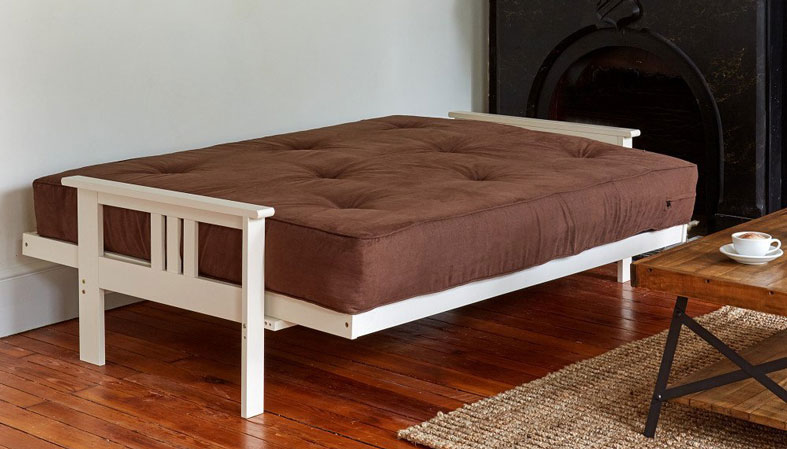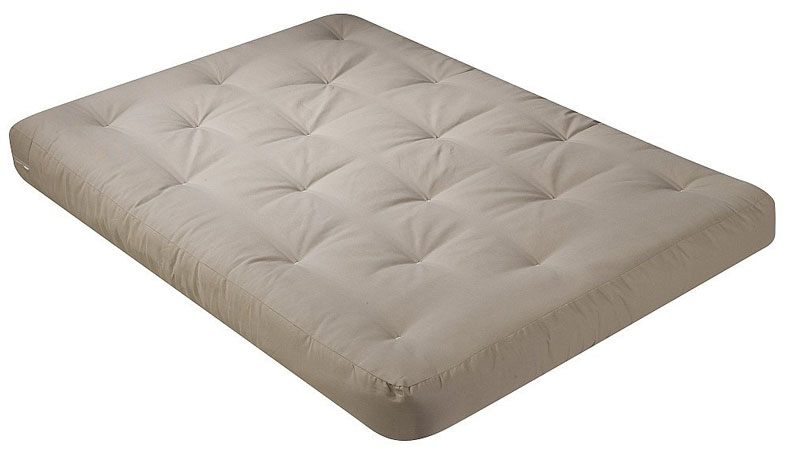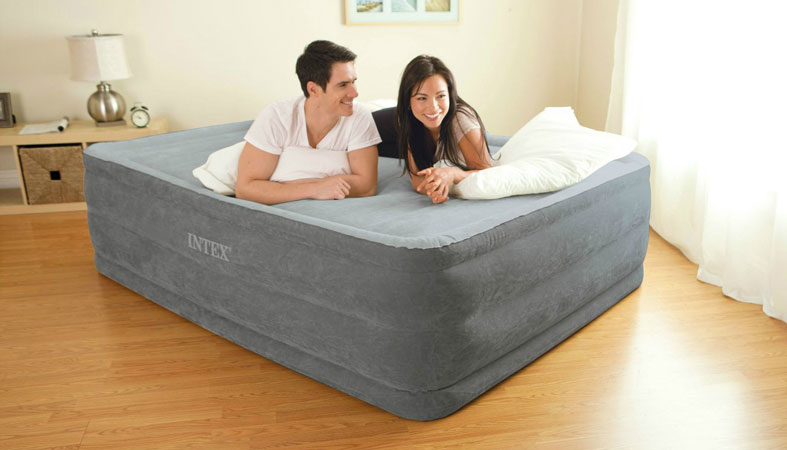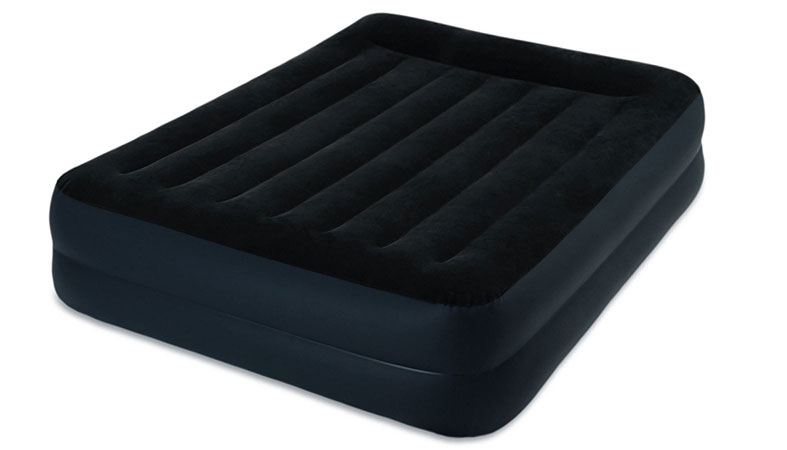Need a new bed for your spare bedroom, but not sure what kind to get? Or are you looking for something for your master bedroom, but you’d like to buy something that’s inexpensive?
If you want an economical, budget-friendly solution, either a futon or an air mattress will be your best bet. Once you’ve narrowed it down to those two choices, now comes the struggle of deciding which one is better. They both have their pros and cons, but depending on your exact situation, one will emerge as a clear winner.
In this article, we’ll help you weigh the pluses and minuses of a futon vs. an air mattress.
Overview – Inflatable Bed vs. a Futon
Despite their lower price ranges, futons are typically more expensive. The only exception is if you get a premium air mattress with all the bells and whistles like a pillow top, raised surface or a built-in electric pump.
They do share a key characteristic, however. They’re both ideal for homes with limited space. Since a futon can be folded and an air mattress can be either deflated or moved, if you’re tight on square footage, these beds are a lifesaver.
Both futons and blow-ups are also multi-purpose, though the purposes they each serve are drastically different. For example, a futon can double as a couch, while an air mattress is portable enough to take with you camping.
What is a Futon?
Designed in Japan in the 17th century, the first futons were thinly padded mattresses that unrolled on to the floor. The original Japanese futon designs were simple and utilitarian, but this product category has now evolved into low-profile couches with intricate frames and multiple sizes ranging from twin to king. The addition of frames in the 1970s allowed them to double function as a sofa or a regular bed.
Pros and Cons
Higher end futons can be expensive, so if you’re looking to save money, you’ll have to shop around. And unless, they have a removable cover, cleaning them is going to be a hassle.
In our opinion, the best futon mattresses shine in their versatility. They’re a stylish addition to a room whether they function as a sleeping area or a sofa. They’re also adept at being tucked into the wall in a Murphy style configuration.
Perhaps the best thing about a futon is its durability. While traditional mattresses can sag over time, futons last can last for years if properly maintained.
Ease of Cleaning
Cleaning a futon can be a nightmare as well as an expensive undertaking. Most futons don’t have removable covers, so you have to wash the whole thing. The removable covers aren’t always attractive, so you’ll want to decide in advance if you’re willing to sacrifice a bit of style for convenience.
There are cleaning protocols that hygiene experts recommend for keeping your futon clean.
- Hang in sunlight once per month. Sunlight kills germ and bacteria while creating a fresh scent.
- Vacuum the surface regularly.
- Wash thoroughly when spills or stains from pets or children occur. Or, take it to the dry cleaner.
- Spot treat when needed.
Affordability
Regardless of the size and quality you decide to get, most futons will be less expensive than a traditional mattress, yet pricier than a blow-up mattress.
Firmness
While they have a reputation for being too firm, they’re now available in multiple comfort levels, ranging from soft to relatively hard, i.e., “extra firm.” If you have back pain, you’ll be able to find a more customizable solution than you’d be able to with an inflatable solution.
Versatility
This category is where futons shine. Whether you’ve got a small room, a spare bedroom, a home office, or you’re furnishing a college dorm room, you’ll love how flexible and versatile these beds are. To get the most bang for your buck, get an adjustable frame that allows you to use it as a couch during the day and, then you can flatten it out into a bed at night.
Design
Designs have come a long way since the flat slab of cotton with a boring upholstery cover. Now, many futons have tufted stitching that more resembles the look of a high-end couch. Frames has also evolved. There are options for wood and metal with about every color and finish imaginable.
Perhaps the most innovate recent designs we’ve observed are removable arms and even sectional L-shaped structures with storage.
What is an Air Mattress?
An air mattress, also referred to as an inflatable or blow-up bed, is just what it sounds like. It’s a bed you can sleep on that’s filled with air. It’s lightweight, portable, and inexpensive, but may not be as comfortable. Durability is a potential issue, too, as inflatable mattresses can pop easily.
Read More: Best Air Mattresses
Pros and Cons
The biggest pro when it comes to inflatable bedding is the price. Second to that is the ease of transport and its lightweight nature. If you’re having guests over, you can inflate it quickly for a guest bedroom or living room sleeping arrangement. Or, take it camping with you. When it’s not in use, just deflate it and put it away.
Air mattresses have a reputation for not being as comfortable as a futon or regular bed. There are steps you can take, however, to make it feel a lot better (more on that later).
Ease of Cleaning
Most of these beds can be cleaned with a simple washcloth. This is because the top layer is usually waterproof. If something spills, it’ll likely pool up and sit on the top, and then you just wipe it away or blot it with ease.
Need more info? See our complete guide on how to clean an air mattress.
Affordability
This is one of the most affordable sleeping solutions you can find. They start as low as $10 and top out at a couple hundred bucks, max.
Firmness
These beds tend to be soft because they’re filed air. If you’re a stomach sleeper, you should steer away from this as your primary sleeping solution because you won’t get the support you need in your chest or low back.
Versatility
Since you can take this mattress with you, it doesn’t get much more versatile than that. Plus, they come in a range of sizes from twin all the way up to king. If you’re taking it with you, make sure you’re in a place where you have access to an outlet for a pump. Otherwise, you’re going to need a lot of air in your lungs to inflate it.
Design
The design is simple and most look nothing like a high-end bed. However, you can get a model that has a frame and also dress it up with quality bedding for a more realistic looking bed.
Frequently Asked Questions
How can I make my futon and/or inflatable bed more comfortable?
The bedding you choose will make a big difference when it comes to comfort. Getting soft sheets and supportive pillows is the first step. If you find that the sleeping surface is too firm, or you’re not getting enough support, you can also get a mattress topper or pad to adjust how the top of the bed feels.
One unique solution is to combine an air mattress and a futon. You would do this by putting the futon as the base and layering an inflatable bed on top of it.
Read More: How to Make A Futon More Comfortable
Which one is better for camping?
Hands down, a blow-up bed is better for camping. Even if you have a thin futon that rolls, it’ll be heavy, bulky, and hard to keep clean.
If you’re going camping, definitely choose something portable and inflatable/deflatable like a blow-up.
Conclusion
When it comes time to decide which one of these solutions is best for you, keep in mind what you hope to achieve with this bed.
Evaluate the following:
- Purpose: Is it going to be a permanent fixture in a bedroom or something that you need only occasionally for guests? Do you need to be able to travel with it?
- Frequency: Are you going to sleep on it every night as a primary bed, or only occasionally?
- Comfort: Do you have back pain or a health condition that makes higher end comfort a priority?
- Budget: Is your budget over or under $150?
- Design: Do you want something that looks stylish in the room it’s in, or is that not important?
Once you figure out the answers to these questions, you’ll have a better understanding of the function the bed will provide, and which option best fits your needs.
More Reading:
- Should You Be Sleeping on an Air Bed Every Night?
- 70 Different Bed Styles, Types and Frames – The Ultimate Buying Idea List
Jill Zwarensteyn
Editor
About Author
Jill Zwarensteyn is the Editor for Sleep Advisor and a Certified Sleep Science Coach. She is enthusiastic about providing helpful and engaging information on all things sleep and wellness.
Combination Sleeper




